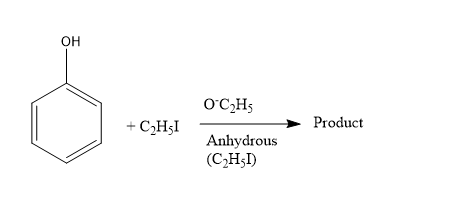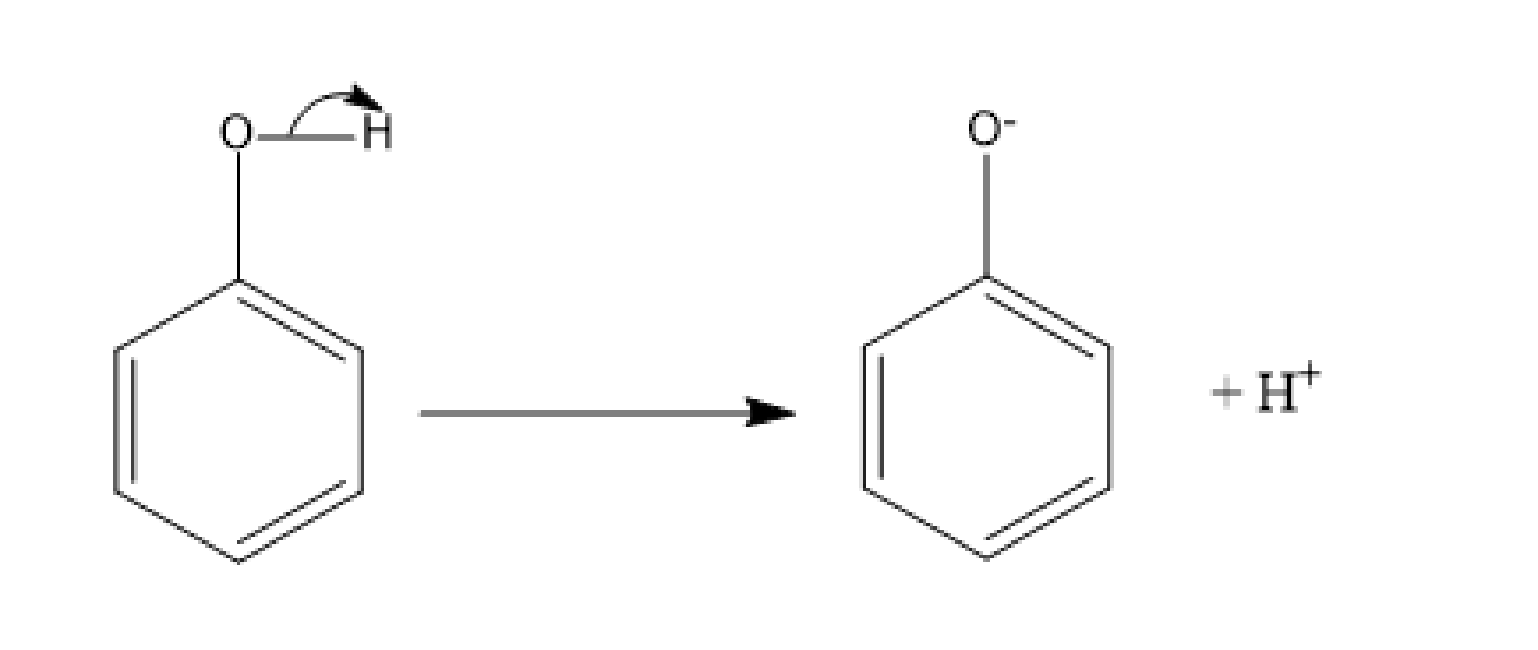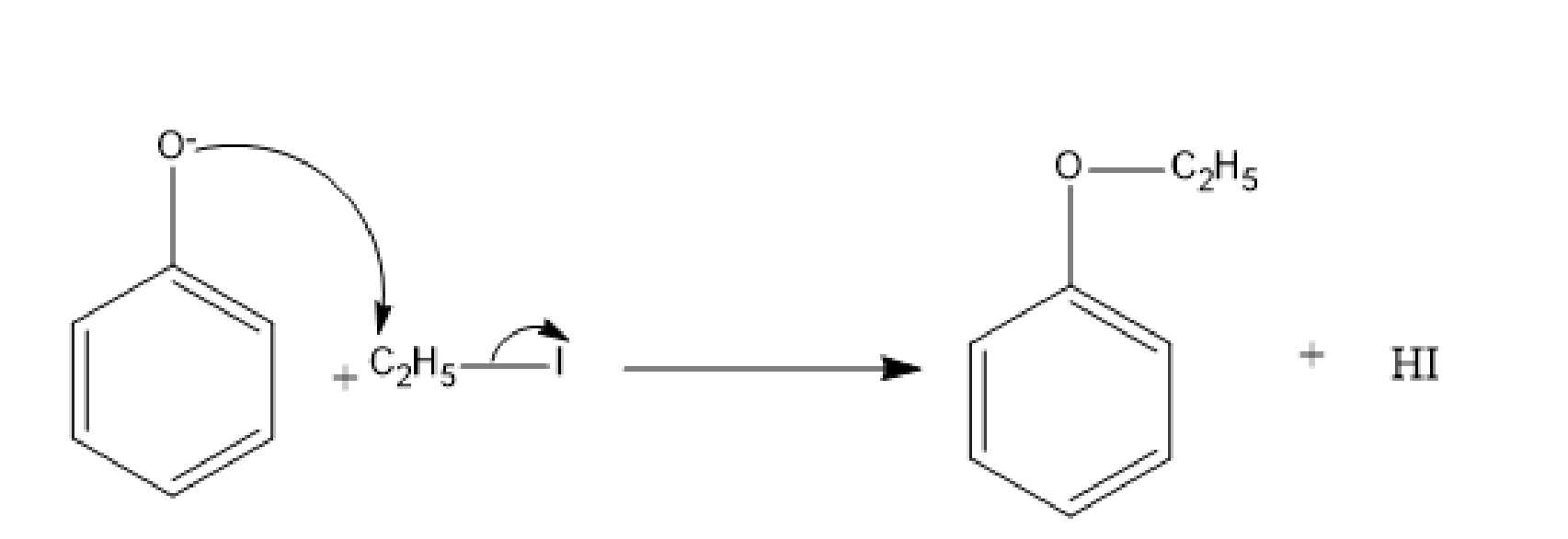
In the above reaction product is

(A) \[{{\rm{C}}_{\rm{6}}}{{\rm{H}}_{\rm{5}}}{\rm{O}}{{\rm{C}}_{\rm{2}}}{{\rm{H}}_{\rm{5}}}\]
(B) \[{{\rm{C}}_2}{{\rm{H}}_{\rm{5}}}{\rm{O}}{{\rm{C}}_{\rm{2}}}{{\rm{H}}_{\rm{5}}}\]
(C) \[{{\rm{C}}_{\rm{6}}}{{\rm{H}}_{\rm{5}}}{\rm{O}}{{\rm{C}}_6}{{\rm{H}}_{\rm{5}}}\]
(D) \[{{\rm{C}}_{\rm{6}}}{{\rm{H}}_{\rm{5}}}{\rm{I}}\]
Answer
224.7k+ views
Hint: An ether is a functional group in which two alkyl groups are attached to the oxygen atom. In a chemical reaction, ether is written as R-O-R. There are many methods of preparation for ether. One such method is Williamson ether synthesis.
Complete Step by Step Solution:
Let's first understand what a Williamson ether synthesis is. In this reaction, deprotonated alcohol undergoes a reaction with an alkyl halide to give ether as a product.
Here, also the reaction is a Williamson ether synthesis. The first step of the reaction is the deprotonation of phenol to form a phenoxide ion.

Fig: Deprotonation of phenoxide ion
In the next step, the electrophilic carbon of the ethyl chloride is attacked by the phenoxide ion and the iodine separates.

Fig: Nucleophilic attack of phenoxide ion
The product formed is \[{{\rm{C}}_{\rm{6}}}{{\rm{H}}_{\rm{5}}}{\rm{O}}{{\rm{C}}_{\rm{2}}}{{\rm{H}}_{\rm{5}}}\] and the hydrogen iodide separates as a by-product.
Therefore, option A is right.
Additional Information: Let's discuss some properties of ether. It is a liquid whose nature is volatile. It has no colour and a pleasant odour. The boiling of ether is comparable with alkanes but less than alcohols. The solubility of ether in water is because of the hydrogen bond formation by the oxygen of ether with the water molecules. But there is a decrease in solubility when the hydrocarbon chain increases.
Note: Ether is a very important compound in many industries. Its use in the manufacturing of hydrocarbons, gums, oil, dyes, resins, and paints is significant. They are also used in lubricating oils. The nature of ether is toxic.
Complete Step by Step Solution:
Let's first understand what a Williamson ether synthesis is. In this reaction, deprotonated alcohol undergoes a reaction with an alkyl halide to give ether as a product.
Here, also the reaction is a Williamson ether synthesis. The first step of the reaction is the deprotonation of phenol to form a phenoxide ion.

Fig: Deprotonation of phenoxide ion
In the next step, the electrophilic carbon of the ethyl chloride is attacked by the phenoxide ion and the iodine separates.

Fig: Nucleophilic attack of phenoxide ion
The product formed is \[{{\rm{C}}_{\rm{6}}}{{\rm{H}}_{\rm{5}}}{\rm{O}}{{\rm{C}}_{\rm{2}}}{{\rm{H}}_{\rm{5}}}\] and the hydrogen iodide separates as a by-product.
Therefore, option A is right.
Additional Information: Let's discuss some properties of ether. It is a liquid whose nature is volatile. It has no colour and a pleasant odour. The boiling of ether is comparable with alkanes but less than alcohols. The solubility of ether in water is because of the hydrogen bond formation by the oxygen of ether with the water molecules. But there is a decrease in solubility when the hydrocarbon chain increases.
Note: Ether is a very important compound in many industries. Its use in the manufacturing of hydrocarbons, gums, oil, dyes, resins, and paints is significant. They are also used in lubricating oils. The nature of ether is toxic.
Recently Updated Pages
JEE Main 2025-26 Mock Test: Organic Compounds Containing Nitrogen

JEE Main 2025-26 Organic Compounds Containing Nitrogen Mock Test

JEE Main Chemical Kinetics Mock Test 2025-26: Free Practice Online

JEE Main 2025-26 Organic Compounds Containing Oxygen Mock Test

JEE Main 2025-26 Organic Compounds Containing Halogens Mock Test

Sodium acetate on heating with soda lime produce A class 12 chemistry JEE_Main

Trending doubts
JEE Main 2026: City Intimation Slip and Exam Dates Released, Application Form Closed, Syllabus & Eligibility

JEE Main 2026 Application Login: Direct Link, Registration, Form Fill, and Steps

Understanding the Angle of Deviation in a Prism

Hybridisation in Chemistry – Concept, Types & Applications

How to Convert a Galvanometer into an Ammeter or Voltmeter

Ideal and Non-Ideal Solutions Explained for Class 12 Chemistry

Other Pages
NCERT Solutions For Class 12 Chemistry Chapter 1 Solutions - 2025-26

JEE Advanced Marks vs Ranks 2025: Understanding Category-wise Qualifying Marks and Previous Year Cut-offs

Solutions Class 12 Chemistry Chapter 1 CBSE Notes - 2025-26

NCERT Solutions ForClass 12 Chemistry Chapter Chapter 4 The D and F Block Elements

Biomolecules Class 12 Chemistry Chapter 10 CBSE Notes - 2025-26

NCERT Solutions For Class 12 Chemistry Chapter 10 Biomolecules - 2025-26




